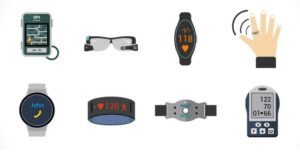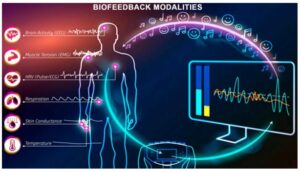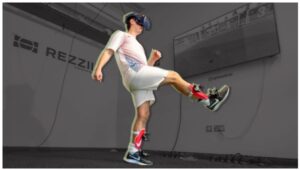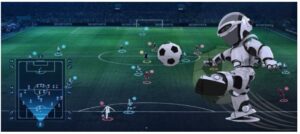The Impact Of Technology On Performance

Introduction
Technology has revolutionized many aspects of our lives, including how we work, communicate, and entertain ourselves. In recent years, technology has also become increasingly important in the world of sports and performance, with the emergence of wearable devices, biofeedback tools, and digital tracking and optimization tools. While technology has the potential to enhance performance, it is important to use it responsibly and be aware of the potential risks and downsides.
In my life to technology has played a great role in accelerating my performance in all areas of my life. Although I use wearables, and other digital tools I have been getting maximum bang for my buck from binaural beats. Meditating daily to binaural beats with subliminal messages has completely transformed my life. I have been meditating for half an hour every morning and sometimes at night too, and the effects have been mind-blowing.

The binaural beats take me deep into a state of relaxation and calmness that I never thought was possible. I usually meditate to alpha or theta brain waves in the morning and occasionally to delta waves at night. The subliminal messages have also helped me to reprogram my subconscious mind with positive affirmations, which have had a significant impact on my mindset and productivity.
The peace and calmness I feel after each session is unbelievable, and the effects have carried over into other areas of my life as well. I find myself more focused and productive at work, and I’m able to handle stress and anxiety much better than before. I feel more connected to my inner self and my intuition, which has helped me to make better decisions in my personal and professional life.
While I know that the effects of binaural beats may vary from person to person, I can say without a doubt that it has been a game-changer for me. I feel more centred, focused, and productive than ever before, and I credit my daily meditation practice with binaural beats for that. If you’re curious about trying binaural beats, I would highly recommend giving it a try and seeing how it affects you.
Another technological tool which has helped me meet my running goals and keep me running consistently is an app. I discovered the Strava app in 2019. At first, I used the app to track my runs and monitor my progress. I was amazed at how easy it was to see my pace, heart rate, and other metrics in real-time. This information helped me set goals and improve my performance over time. I also started to join challenges and connect with other runners on the app.
One challenge, in particular, caught my eye. It was a monthly challenge to run a minimum distance of 300 kilometres. It seemed like an impossible feat, but I decided to give it a try. With the help of the Strava app, I was able to track my progress and stay motivated throughout the month.
At the end of the month, I completed the challenge and felt a sense of accomplishment like never before. This success fueled my passion for running and I started to set bigger goals for myself.

I decided to start running a half or full marathon every week. Again, the Strava app was my go-to tool for tracking my progress and monitoring my performance. The app’s features allowed me to compare my current performance with previous years and months, as well as with other runners I followed. This helped me to stay motivated and challenged me to push myself harder every week.
The Strava app has been a game-changer for me. Keeping track of my runs, generating stats, and challenging myself to take on new goals, have made me a consistent performer and installed the habit of running into me. Without the app, I wouldn’t be able to complete a half or full marathon every week or achieve a minimum distance of 300 km every month. Technology has truly made a difference in my life, and I am grateful for the Strava app for helping me become a better and healthier version of myself.
Further, In both the money Moneyball and the book The Art of Learning, technology played a key role in helping individuals achieve peak performance. By leveraging data analytics and other tools, these individuals were able to gain insights and identify opportunities for improvement that might have been missed using traditional methods. The use of technology allowed them to work smarter, not harder, and achieve better results with less effort.

For instance, Moneyball is the story of how the Oakland A’s, a struggling baseball team with a limited budget, turned to data analytics to build a competitive team. The team’s general manager, Billy Beane, hired a young economics graduate named Peter Brand to help him identify undervalued players using statistical analysis. Together, they used a computer program to analyze player data and identify players who were likely to perform well based on their performance metrics, rather than relying on traditional scouting methods.
The use of data analytics revolutionized the way baseball teams evaluated players and helped the A’s achieved a remarkable level of success despite their limited budget. By focusing on the numbers rather than the conventional wisdom, they were able to identify talented players who were overlooked by other teams and build a team that could compete with much wealthier organizations.
The use of technology was crucial to the success of Moneyball. The computer program used by the A’s allowed them to analyze vast amounts of data quickly and efficiently, and identify patterns and trends that would have been difficult or impossible to spot using traditional methods. The program also allowed the A’s to simulate various scenarios and predict the likely outcome of different strategies, helping them make better decisions about which players to acquire and how to use them.

And the book Art of Learning is a memoir of Josh Waitzkin, a chess prodigy who later became a world champion in Tai Chi Chuan Push Hands. Waitzkin attributes much of his success to his ability to learn and adapt quickly, which he developed through his training in chess and martial arts.
One of the key strategies Waitzkin used to improve his performance was the use of technology. He used computer programs to analyze his chess games and identify areas where he could improve, and he used video cameras to record his Tai Chi Chuan Push Hands matches so that he could review and analyze his performance.
Waitzkin also used technology to improve his mental and emotional state. He practised meditation and used biofeedback devices to monitor his heart rate and other physiological signals, allowing him to achieve a state of deep relaxation and focus.
TECHNOLOGICAL TOOLS FOR ENHANCING PERFORMANCE
There are various tech tools for enhancing performance, Some of the types of tech tools are discussed below.

Wearable Devices
Wearable devices are electronic devices that can be worn on the body, such as fitness trackers, smartwatches, and heart rate monitors. These devices can track various biometric data points, including heart rate, calories burned, steps taken, and sleep quality. They can also provide real-time feedback and reminders, such as reminding the wearer to stand up and move around if they have been sitting for too long.
Wearable devices can be incredibly useful for athletes and fitness enthusiasts, as they can help them track their progress and identify areas where they can improve. For example, a runner can use a GPS- enabled smartwatch to track their distance, pace, and elevation gain during a run, and use that data to adjust their training regimen. A weightlifter can use a fitness tracker to track their heart rate and calorie burn during a workout and adjust their intensity accordingly.
However, there are potential downsides to wearable devices as well. For example, some people may become too reliant on their devices and lose sight of their instincts and intuition. Additionally, wearable devices can sometimes be inaccurate or unreliable, leading to incorrect data and potentially harmful decisions.

Biofeedback
Biofeedback is a type of therapy that involves using electronic sensors to measure physiological responses such as heart rate, muscle tension, and skin conductance. The goal of biofeedback is to help individuals learn how to control these responses and improve their overall health and well-being.
Biofeedback can be especially useful for athletes and performers, as it can help them learn how to control their stress levels and focus their attention more effectively. For example, a golfer might use biofeedback to learn how to control their heart rate and breathing during a putt, allowing them to stay calm and focused under pressure.
Digital Tools for Tracking and Optimizing Performance
In addition to wearable devices and biofeedback, there are also a variety of digital tools available for tracking and optimizing performance. These tools can include apps for tracking nutrition and hydration, software for analyzing movement and technique, and virtual reality simulators for practising skills and scenarios.

These digital tools can be incredibly helpful for athletes and performers, as they can provide real-time feedback and allow for more precise and effective training. For example, basketball players might use a motion capture system to analyze their shooting form and identify areas where they can improve. A football player might use a virtual reality simulator to practice plays and scenarios in a safe and controlled environment.
Responsible Use of Technology
While technology can be a powerful tool for enhancing performance, it is important to use it responsibly and be aware of the potential risks and downsides. For example, relying too heavily on wearable devices and digital tools can lead to a lack of intuition and instinct, and can potentially lead to overtraining or injury. Additionally, there is always the risk of technology malfunctioning or being inaccurate, which can lead to incorrect data and harmful decisions.
To use technology responsibly, it is important to remember that technology should always be a supplement to, not a replacement for, human intuition and judgment. Athletes and performers should also be aware of the potential risks and downsides of technology and should seek out expert guidance and advice when using new tools or techniques.
USE OF AI FOR PEAK PERFORMANCE
AI (Artificial Intelligence) is increasingly being used in the world of sports and performance to enhance training, strategy, and performance. One example of AI being used for peak performance can be found in the science fiction film “Ex Machina” directed by Alex Garland. In the movie, a brilliant and wealthy tech entrepreneur creates an advanced AI humanoid robot named Ava intending to create the perfect artificial being.
Throughout the film, the entrepreneur uses various techniques to test Ava’s intelligence and consciousness, including a series of sophisticated algorithms that allow her to learn and adapt to her environment. The algorithms use machine learning to analyze data and make predictions about how Ava will behave in different situations, allowing her to constantly improve her performance.

While the main focus of the film is on the development of Ava’s consciousness, it also demonstrates how AI can be used to optimize performance and achieve peak performance. By analyzing vast amounts of data and making predictions based on that data, AI can help individuals and organizations identify areas where they need to improve, optimize their training and performance, and achieve their goals more
efficiently.

And similarly in the book “Superintelligence: Paths, Dangers, Strategies” by Nick Bostrom, AI is discussed as a potential tool for achieving peak performance in various fields. Bostrom argues that AI has the potential to revolutionize many areas of human activity, from medicine and science to business and finance.
For example, AI could be used to analyze massive amounts of data on patient health to identify patterns and trends that could help doctors make more accurate diagnoses and develop more effective treatments. In business and finance, AI could be used to analyze vast amounts of data on markets and consumer behaviour, allowing companies to make more informed decisions about product development and marketing strategies.
Overall, AI has the potential to transform many areas of human activity and help individuals and organizations achieve peak performance in ways that were previously impossible. However, it’s important to approach AI with caution and consider the potential risks and ethical implications of its use.

In addition to analyzing performance data, AI can also be used to simulate and predict game scenarios. For example, AI can simulate different scenarios in a football game and provide recommendations for optimal play calling based on the predicted outcomes of each scenario.
Overall, AI has the potential to revolutionize the world of sports and performance by providing athletes and coaches with powerful tools for analysis, optimization, and prediction. However, it is important to use AI responsibly and be aware of the potential risks and downsides, such as over-reliance on data and loss of intuition and instinct. It’s important to approach AI with caution and consider the potential risks and ethical implications of its use.
SOME IMPORTANT TECHNOLOGICAL TOOLS/DEVICES FOR ENHANCING PERFORMANCE

There are many technological gadgets and devices available in the market that can be used to enhance peak performance in various fields. Some of these devices include:
Wearable Fitness Trackers: We have already discussed this above.
Smartwatches: Smartwatches are similar to fitness trackers but also have additional features such as GPS tracking, mobile payments, and the ability to receive notifications from smartphones.
Biometric Sensors: These sensors can be used to measure various biometric data such as muscle activity, skin conductance, and brain waves. They can be used to provide feedback on stress levels, relaxation techniques, and optimal training intensity.
Virtual Reality (VR) and Augmented Reality (AR) Headsets: VR and AR headsets can be used to create immersive training experiences and simulate real-life scenarios. For example, VR headsets can be used to simulate high-pressure game situations in sports.
Electronic Muscle Stimulators: These devices use electrical impulses to stimulate muscles and improve muscle strength and recovery. They can be used to target specific muscle groups and improve performance in sports and other physical activities.
Cognitive Training Apps: These apps use games and exercises to improve cognitive function and mental agility. They can be used to improve focus, memory, and decision-making skills in sports and other performance-related fields.
Smart Recovery Tools: These devices use vibration therapy, compression therapy, and other techniques to aid in recovery and reduce soreness and inflammation after physical activity. They can be used to speed up recovery time and improve overall performance. Overall, these devices can be powerful tools for enhancing performance in various fields, but it is important to use them responsibly and be aware of potential downsides such as over-reliance on data and loss of intuition and instinct.
NEW GAME-CHANGING TECH TOOLS IN DEVELOPMENT FOR FUTURE
The field of peak performance is constantly evolving, and new game-changing tech tools are being developed all the time. Here are a few examples of cutting-edge tech tools that are currently in development and have the potential to revolutionize the world of peak performance:

Brain-Computer Interfaces (BCIs): BCIs are devices that allow direct communication between the brain and external devices. They can be used to control prosthetic limbs, communicate with computers, and even control virtual environments. In the world of peak performance, BCIs could be used to enhance cognitive function and improve reaction time and decision-making skills.
Wearable Tech for Mental Health: Wearable devices are currently being developed that can monitor biometric data related to mental health, such as heart rate variability, sleep quality, and stress levels. This data can be used to provide personalized recommendations for improving mental health and cognitive function.
Smart Clothing: Smart clothing is being developed that can monitor biometric data such as heart rate, breathing rate, and body temperature. This data can be used to provide real-time feedback on training intensity and recovery time, as well as monitor for signs of injury or illness.
AI-Assisted Training: AI is being used to develop personalized training programs that take into account an individual’s unique physiological and psychological profile. By analyzing biometric data and other performance metrics, AI can provide recommendations for optimal training intensity, duration, and recovery time.
Virtual Reality Training: Virtual reality is being used to create immersive training experiences that simulate real-world scenarios. For example, virtual reality can be used to simulate high-pressure game situations in sports, allowing athletes to train under conditions that closely mimic the demands of competition.
These are just a few examples of the exciting new tech tools that are currently in development and have the potential to revolutionize the world of peak performance. As technology continues to advance, we can expect to see even more innovative tools and techniques that can help us reach our full potential in sports, work, and life.
Conclusion
Technology has the potential to revolutionize the world of sports and performance conclusion, technology has had a significant impact on performance, both positive and negative. From wearable fitness trackers to brain-computer interfaces, countless technological gadgets and devices can be used to enhance performance in various fields. These tools can help us monitor progress, improve cognitive function, and create immersive training experiences that simulate real-world scenarios. However, it is important to use these tools responsibly and be aware of potential downsides such as over-reliance on data and loss of intuition and instinct.

As technology continues to evolve, we can expect to see even more innovative tools and techniques that can help us reach our full potential in sports, work, and life. However, we must also be mindful of the potential risks and ensure that we use technology in a way that supports our overall health and well- being. By using technology responsibly and in conjunction with traditional training methods, we can achieve peak performance and reach oursafely and sustainably.
 Dr K. Jayanth Murali is a retired IPS officer and a Life Coach. He is the author of four books, including the best-selling 42 Mondays. He is passionate about painting, farming, and long-distance running. He has run several marathons and has two entries in the Asian book of Records in full and half marathon categories. He lives with his family in Chennai, India. When he is not running, he is either writing or chilling with a book.
Dr K. Jayanth Murali is a retired IPS officer and a Life Coach. He is the author of four books, including the best-selling 42 Mondays. He is passionate about painting, farming, and long-distance running. He has run several marathons and has two entries in the Asian book of Records in full and half marathon categories. He lives with his family in Chennai, India. When he is not running, he is either writing or chilling with a book.

May 4, 2023 at 6:35 PM /
I’d should test with you here. Which is not something I usually do! I take pleasure in reading a post that can make folks think. Also, thanks for permitting me to comment!